
The sap beetles, also known as Nitidulidae, are a family of beetles.

The scarlet lily beetle, red lily beetle, or lily leaf beetle, is a leaf beetle that eats the leaves, stem, buds, and flowers, of lilies, fritillaries and other members of the family Liliaceae. It lays its eggs most often on Lilium and Fritillaria species. In the absence of Lilium and Fritillaria species, there are fewer eggs laid and the survival rate of eggs and larvae is reduced. It is now a pest in most temperate climates where lilies are cultivated.

Bulbophyllum fletcherianum, the tongue orchid, Fletcher's bulbophyllum or Spies' bulbophyllum, is a rare orchid native to southern New Guinea. It prefers sunny rock outcrops or mossy tree branches, but besides being lithophytic or epiphytic, it can also be pseudo-terrestrial. The tongue orchid requires high humidity and moist roots.
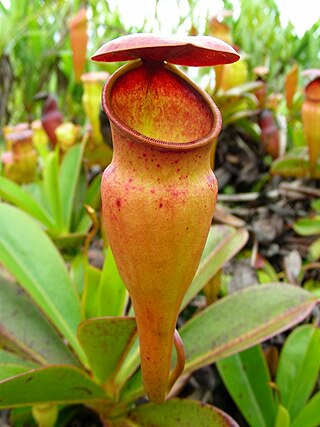
Nepenthes pervillei is the only pitcher plant found in the Seychelles, where it is endemic to the islands of Mahé and Silhouette. It grows in rocky areas near granitic mountain summits, its roots reaching deep into rock fissures. The species has an altitudinal range of 350–750 m above sea level. Like all members of the genus, N. pervillei is dioecious, having separate male and female plants.
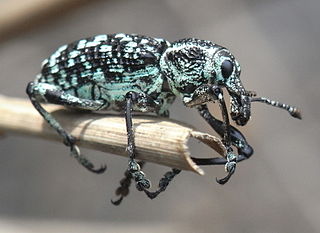
Chrysolopus spectabilis is a species of weevil found in south-eastern Australia. It was discovered during James Cook's first voyage, and became one of the first insects to be described from Australia. The weevil measures up to 25 mm (1.0 in) long and includes distinctive metallic green and black scales. It is found only on 28 species of the plant genus Acacia.

The Chrysomelinae are a subfamily of leaf beetles (Chrysomelidae), commonly known as broad-bodied leaf beetles or broad-shouldered leaf beetles. It includes some 3,000 species around the world.
Mount Finke is a monadnock in the Australian state of South Australia, located in the gazetted locality of Yellabinna about 125 kilometres (78 mi) north of Ceduna.
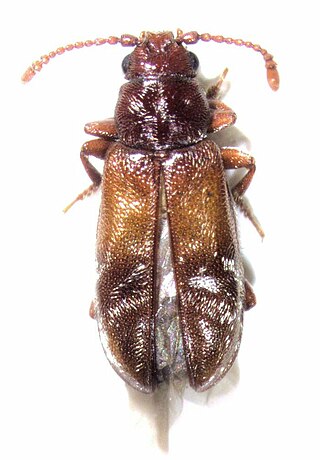
Cavognathidae is a family of beetles, in the superfamily Cucujoidea. It contains a single genus, Taphropiestes with around a dozen species known from South America, Australia and New Zealand. In Australian and New Zealand species adults and larvae have been found living in bird nests, but their ecology is unclear, but they are possibly scavengers.

Julodimorpha is a genus of beetles in the family Buprestidae, containing the following species:

Julodimorpha bakewelli is a species of beetle in the family Buprestidae. It was first described by Adam White in 1859.
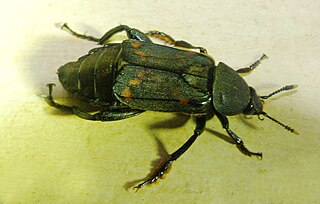
Diamesus is a genus of rather large carrion beetle with two species distributed in tropical Asia and Australia. Like other Silphinae, it has an antenna with 11 segments. About 3 or 4 abdominal segments are visible beyond the tip of the elytra. The elytra themselves have longitudinal keels. The type species is Diamesus osculans. The larvae are broad and flat and somewhat cockroach-like (blattiform).
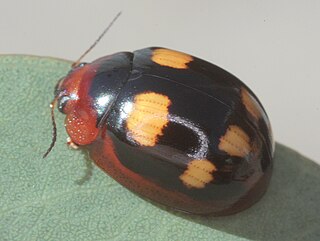
Paropsisterna is a genus of leaf beetles indigenous to Papua New Guinea and Australia. There are over 120 species, many with bright aposematic colours, and many feeding on Eucalyptus leaves.

Paropsisterna agricola or southern eucalyptus leaf beetle, is a small hemispherical leaf beetle. They can vary from golden to grey. They have some black markings on the pronotum. The epipleura (skirt) is sometimes red.
Anoplognathus aureus, commonly known as the gold Christmas beetle, is a beetle of the family Scarabaeidae native to northern Australia, from northeastern Queensland to northern Western Australia. It is prized by collectors.
Marianne Horak is a Swiss-Australian entomologist who specialises in Australian Lepidoptera, particularly the phycitine and tortricid moths. She also did important research on the scribbly gum moths, during which eleven new species of Ogmograptis were discovered.

Paropsis charybdis, commonly known as the Eucalyptus tortoise beetle, is a species of leaf beetle belonging to the genus Paropsis. It is considered a pest of some species of Eucalyptus.
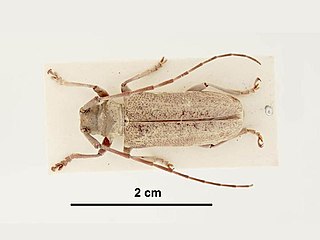
Acalolepta vastator is a species of beetle in the family Cerambycidae. It was described by Newman in 1841, originally under the genus Monohammus. Breuning erroneously synonymised this species with Acalolepta mixta. It is found throughout eastern Australia, including Tasmania and South Australia, as well as parts of South Asia. The Australian government recognize this species as a pest species. It feeds on grape vine, papaya and curtain fig tree.
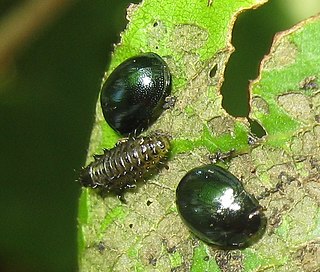
Chrysomelini is a tribe of leaf beetles in the family Chrysomelidae. There are over 150 described genera in Chrysomelini, variously arranged into subtribes, though the exact number and constituency of these subtribes is a source of ongoing debate.

Myrabolia is the only genus in the beetle family Myraboliidae in the superfamily Cucujoidea. It has about 13 species, found in Australia. Adults and possibly larvae live under the bark of Eucalyptus trees.
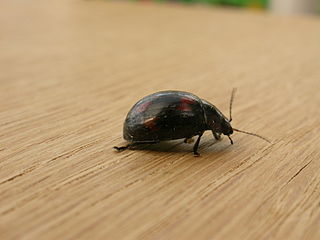
Paropsisterna beata, commonly known as the blessed leaf beetle, is a species of leaf beetle. It occurs in all states of Australia except Tasmania.
















